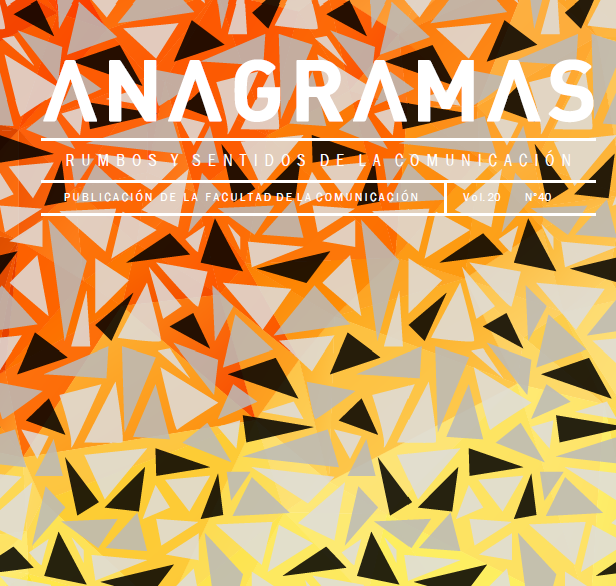Identidad colectiva a partir del arte urbano en Medellín, Colombia
Contenido principal del artículo
Resumen
Este artículo recoge los resultados de una investigación que propone comprender la relación entre los colectivos sociales en los territorios y las manifestaciones de arte urbano, como agentes de construcción identitaria en Medellín, Colombia. La metodología implementada fue cualitativa, de corte fenomenológico, cuyo alcance fue descriptivo. Se realizó un análisis de contenido a partir de las manifestaciones de arte urbano identificadas y su relación con la construcción de identidad a partir de la convivencia estética. Se realizaron entrevistas semiestructuradas a miembros de diversos colectivos de arte urbano en el centro, occidente y sur de la ciudad, rastreados a partir de la etnografía visual. Dichos territorios comprenden la Comuna 13, el Corredor Vial del Tranvía de Ayacucho y la zona centro y sur como una unidad estética. A partir de ello, se propuso una reconstrucción histórica del arte urbano en Medellín y el análisis comparativo de dos tipos de intervención artística en la ciudad: la que surge de las organizaciones sociales locales e independientes, y la que se implementa desde la institucionalidad. Como resultado, se encontró que el arte urbano de la ciudad cuenta sus orígenes en las dinámicas socioculturales independientes, que serían institucionalizadas posteriormente, dinamizando transformaciones históricas, sociales, estéticas y económicas, en los entornos intervenidos. De este proceso surgen identidades colectivas que se derivan de habitar el espacio estético, urbano y público, sea como habitante y/o como protagonista de la intervención artística.
Detalles del artículo
Citas
Arenas Grisales, S. P. (2015). Luciérnagas de la memoria. Altares espontáneos y narrativas de luto en Medellín, Colombia. Revista interamericana de Bibliotecología, 38(3), 189-200.
Alcalá, P. R. (2006). Jóvenes, memoria y violencia en Medellín: Una antropología del recuerdo y el olvido. Estudios Políticos, (30), 185-190. Universidad de Antioquia. https://www.redalyc.org/pdf/164/16429058008.pdf
Álvarez Betancur, L. F. (2018). Los puentes de la memoria: jóvenes, arte y memoria en la ciudad de Medellín. http://bibliotecadigital.udea.edu.co/bitstream/10495/10220/1/AlvarezLuisa_2018_PuentesMemoria.pdf
Agudelo-Pérez, L. (2015). Corredor vial de Ayacucho tendrá su propia galería. El Mundo. https://www.elmundo.com/portal/noticias/movilidad/corredor_vial_de_ayacucho_tendra_su_propia_galeria.php#.XH12O8BKiM8.
Allepuz-García, P. (2014). El Street Art y la (in)cultura urbana: el ejemplo de Córdoba. Arte, Individuo y Sociedad, 26(1), 137-151. http://dx.doi.org/10.5209/rev_ARIS.2014.v26.n1.41107
Ardenne, P. (2006). Un arte contextual. Creación artística en medio urbano, en situación de intervención, de participación. Cendeac.
Báscones, P. (2009). El arte público como agente de revitalización urbana mediante la participación ciudadana.
En B. Fernández Quezada y J. P. Lorente Lorente (coord.), Arte en el espacio público: barrios artísticos y revitalización urbana (pp.145-161). Prensas Universitarias de Zaragoza.
Becker, C. (1990). Social Responsibility and the Place of the Artist in Society. Lake View Press.
Castro, S. (2012). Graffiti Bogotá 2012: Diagnóstico Graffiti Bogotá. Informe final Bogotá: [S.E]. https://www.culturarecreacionydeporte.gov.co/sites/default/files/idartes-diagnosticopubli2014.pdf
Ciria, A. (2003). Contra la democratización del Arte. Thémata. Revista De Filosofía, 30(30), 137-155. https://idus.us.es/xmlui/handle/11441/27624
Derrida, J. (1998). Aporías. Paidós.
Garcés H, A. (2006). Configuraciones espaciales de lo inmigrante: usos y apropiaciones de la ciudad. Papeles del CEIC International Journal on Collective Identity Research, 6(20).
Gaviria-Puerta, N.A. (2015). Grafías en la piel de la ciudad: graffiti y pintadas comerciales como expresiones
sociales reflejadas en las calles de Medellín–Colombia [tesis de doctorado, Universidad Politécnica de Madrid]. Archivo Digital UPM. https://oa.upm.es/40330/
Giménez, G. (2000). Materiales para una teoría de las identidades sociales. En J.M. Valenzuela Arce (coord.), Decadencia y auge de las identidades: cultura nacional, identidad cultural y modernización. (pp. 45-78). El Colegio de la Frontera Norte.
González, C., Gómez-Isla, J., del Río, V. y Santamaría, A. (2017). El papel del arte contemporáneo en la dinamización social del entorno urbano. Un estudio de caso: El barrio del Oeste en Salamanca. Arte, Individuo y Sociedad, 29(2), 299-315. http://dx.doi.org/10.5209/ARIS.53165
Hall, S (1990). Identidad cultural y diáspora en Stuart Hall sin garantías. Trayectorias y problemáticas en
estudios culturales. Envión Editores; IEP; Instituto Pensar; Universidad Andina Simón Bolívar.
Hall, S. (1996). Introducción: ¿quién necesita ‘identidad? En S Hall y P. Du Gay (comps.), Cuestiones de identidad cultural (pp. 13-39). Amorrortu.
Jeihhco. (2014) 'Revolución sin muertos' | TEDxTigre. (2014) [Vídeo]. https://www.youtube.com/watch?v=CjOFGkIu5so
López, B. (2017). Las galerías urbanas de memoria en Medellín. Revista de estudios colombianos, (50), 35-49. https://colombianistas.org/wp-content/themes/pleasant/REC/REC%2050/Ensayos/50_9_ensayo_lopez_baquero.pdf
Museo de Antioquia. (2013, 13 de octubre). Pachamama, patologías geográficas. https://museodeantioquia.co/sitio/noticia/pachamama-patologias-geograficas/
Pulgarín, G. H. (2018). Crear y conjurar la crisis de la ciudad. Diseño urbano e imagen de la ciudad en Montpellier, Francia. Revista Kepes, 15(18), 249-277. http://kepes.ucaldas.edu.co/downloads/Revista18_10.pdf
Ruiz Espinal, M. (2016). En Medellín el arte narra la historia y promueve la transformación social. Bitácora,
Silva, A. (2014). Atmósferas ciudadanas grafiti, arte público, nichos estéticos. Quipus; Ciespal.
Taguenca-Belmonte, J. (2016). La identidad de los jóvenes en los tiempos de la globalización. Revista
Mexicana de Sociología, 78(4). http://revistamexicanadesociologia.unam.mx/index.php/rms/article/view/57234/50780
Villalba, P. (2012). Entre ruinas, lugares y objetos residuales de la memoria. Medellín, Colombia:
Universidad Nacional de Colombia.





